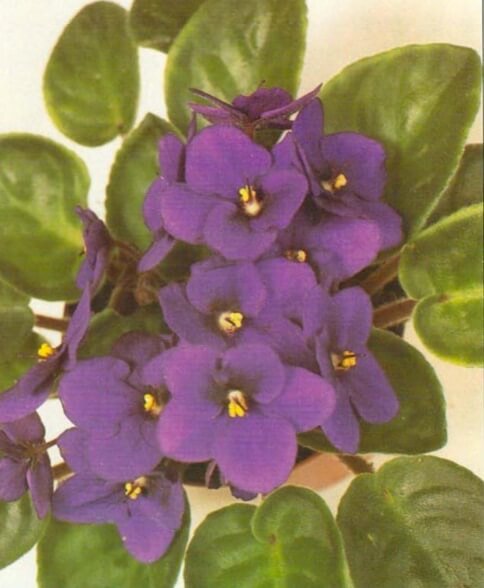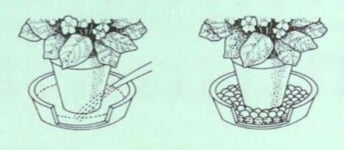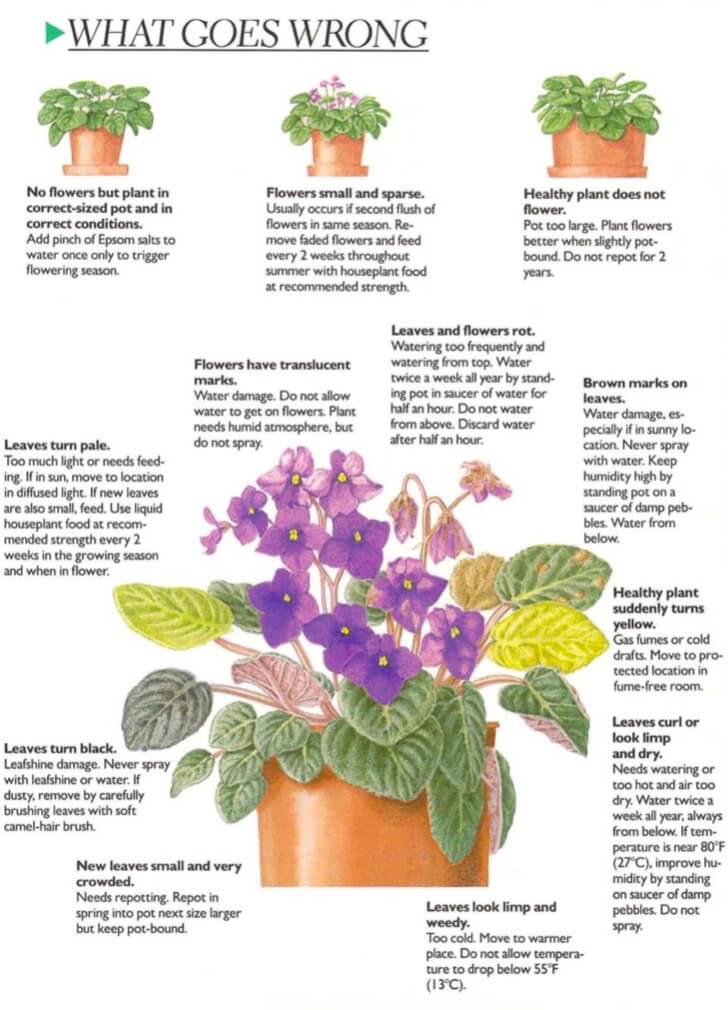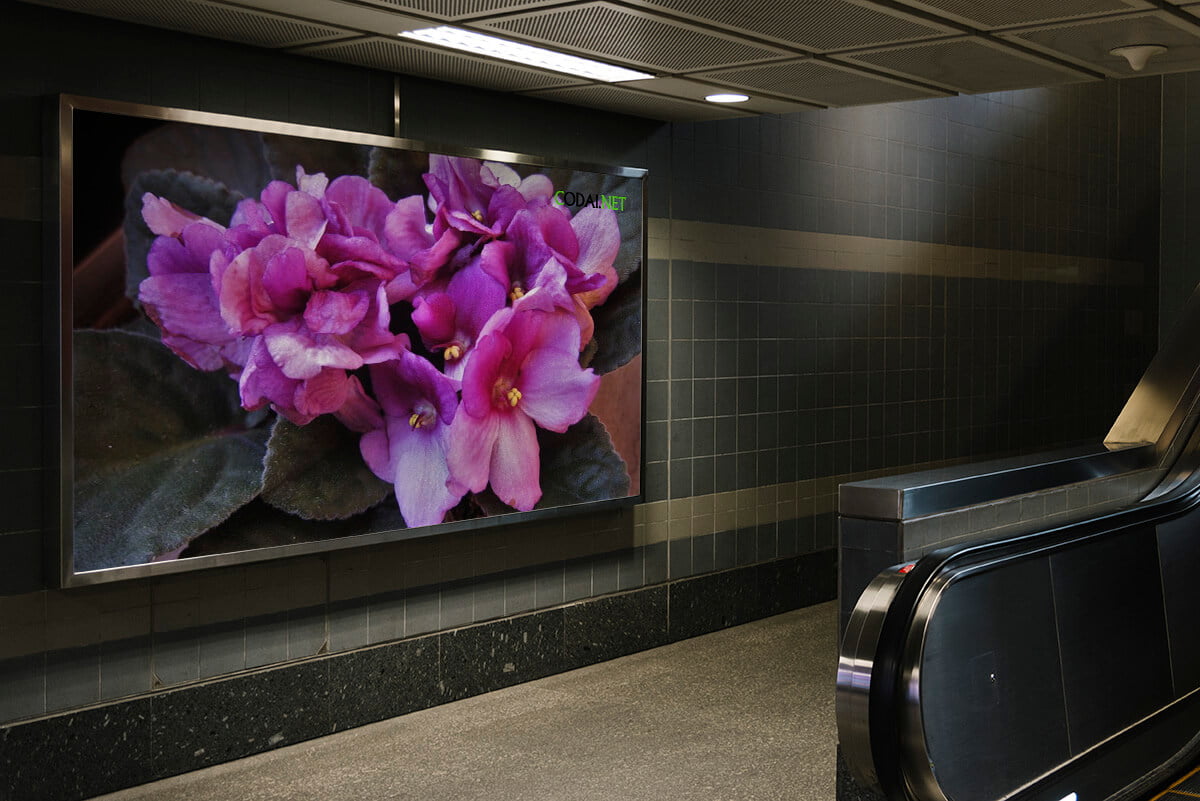[Ebook Việt Hoá] The Instant Guide to Healthy Houseplants (Hướng dẫn tức thời để chăm cây trong nhà khoẻ mạnh), Mục Saintpaulia
[Ebook Việt Hoá] The Instant Guide to Healthy Houseplants: Saintpaulia ionantha (African violet)
- Nguồn: [Ebook Việt Hoá] The Instant Guide to Healthy Houseplants (Hướng dẫn tức thời để chăm cây trong nhà khoẻ mạnh)
- Biên tập: Dũng Cá Xinh
- Biên dịch: Team Codai.net
English
This is one of the undisputed favorites among houseplant growers. The original species of this plant, found in the mountains of east Africa, was blue. It has been hybridized to produce plants that do not drop their flowers so quickly and come in a range of colors, including pink, red, white and bicolor, with single and double flowers. A relatively small pot, warmth and high humidity are all necessary for good flower production. A pinch of Epsom salts added once to the water in early summer will encourage the plant to flower.

Light
- Prefers full light in summer, though direct sunlight in spring and summer is harmful. Will tolerate winter sunshine.
Temperature
- Maintain 60°F (16°C) all year. Tolerates a minimum 55°F (13°C) and a maximum of 80°F (27°C) if humidity is high.
Water
- Twice a week all year, stand potin a saucer and fill saucer tobrim. After half an hour, tip out excess, as pot must not stand in water. Do not water from top of pot.
Feeding
- Every 2 weeks in spring and summer, add liquid houseplant food to water. Throw away excess. Use manufacturer’s recommended strength.
Humidity
- Do not spray. Achieve essential high humidity by standing pot on saucer of pebbles almost covered with water. Remove to another saucer for watering. As an alternative, put pot into another pot with damp peat between.
Soil
- Use peat-based potting soil.
Repotting
- Repot about every 2 years, only when plant looks really overcrowded. Use shallow pots. Maintain overall rosette of leaves by removing leaves pointing towards center of plant whenever necessary.
Cleaning
- Dust with camel-hair brush. Do not spray or use leafshine. Remove dead flowers and old leaves as they occur.
Watering
- Water twice weekly all year. Stand pot in saucer and fill saucer to brim with water. Leave for half an hour, then drain away excess. Do not leave standing in water.

Humidity
- Plant needs high humidity but must not be sprayed. Put pebbles in saucer and stand pot on top. Add water to saucer until it is halfway up pebbles. Do not let bottom of pot touch water.
What’s Wrong

- No flowers but plant incorrect-sized pot and incorrect conditions: Add pinch of Epsom salts to water once only to trigger flowering season.
- Flowers small and sparse.Usually occurs if second flush off lowers in same season: Remove faded flowers and feed every 2 weeks throughout summer with houseplant food at recommended strength.
- Healthy plant does not flower: Pot too large. Plant flowers better when slightly pot-bound. Do not repot for 2 years.
- Leaves turn pale: Too much light or needs feeding. If in sun, move to location in diffused light. If new leavesare also small, feed. Use liquid houseplant food at recommended strength every 2 weeks in the growing season and when in flower.
- Flowers have translucent marks: Water damage. Do not allow water to get on flowers. Plant needs humid atmosphere, but do not spray.
- Leaves and flowers rot: Watering too frequently and watering from top. Water twice a week all year by standing pot in saucer of water for half an hour. Do not water from above. Discard water after half an hour.
- Brown marks on leaves: Water damage, especially if in sunny location. Never spray with water. Keep humidity high by standing pot on a saucer of damp pebbles. Water from below.
- Leaves turn black: Leafshine damage. Never spray with leaf shine or water. If dusty, remove by carefully brushing leaves with soft camel hair brush.
- New leaves small and very crowded: Needs repotting. Repot in spring into pot next size larger but keep pot-bound.
- Leaves look limp and weedy: Too cold. Move to warmer place. Do not allow temperature to drop below 55°F (15°C)
- Healthy plantsuddenly turns yellow: Gas fumes or cold drafts. Move to protected location in fume-free room.
- Leaves curl or look limp and dry: Needs watering or too hot and air too dry. Water twice a week all year, always from below. If temperature is near 80°F (27°C), improve humidity by standing on saucer of damp pebbles. Do not spray.
Tiếng Việt
Đây là một trong những sở thích không thể bàn cãi của những người trồng cây trong nhà. Loài ban đầu của loài thực vật này, được tìm thấy ở vùng núi phía đông châu Phi, có màu xanh lam. Nó đã được lai tạo để tạo ra những cây không rụng hoa quá nhanh và có nhiều màu sắc, bao gồm hồng, đỏ, trắng và nhị sắc, với hoa đơn và hoa kép. Một cái chậu tương đối nhỏ, độ ấm và độ ẩm cao đều cần thiết để cho hoa tốt. Thêm một chút muối Epsom vào nước vào đầu mùa hè sẽ kích thích cây ra hoa.

Ánh sáng
- Ưa ánh sáng đầy đủ vào mùa hè, mặc dù ánh nắng trực tiếp vào mùa xuân và mùa hè là có hại. Chịu được ánh nắng mùa đông.
Nhiệt độ
- Duy trì nhiệt độ 60 độ F (16 độ C) cả năm. Chịu đựng tối thiểu 55 độ F (13 độ C) và tối đa là 80 độ F (27 độ C) nếu độ ẩm cao.
Nước
- Hai lần một tuần trong năm, đặt nồi trong đĩa và đổ đầy đĩa đến vành. Sau nửa giờ, vớt phần thừa ra ngoài, vì chậu không được đọng trong nước. Không tưới nước từ miệng chậu.
Bón phân
- Cứ 2 tuần một lần vào mùa xuân và mùa hè, hãy thêm phân bón lỏng vào nước. Vứt bỏ những thứ dư thừa. Sử dụng nồng độ khuyến nghị của nhà sản xuất.
Độ ẩm
- Không xịt. Đạt được độ ẩm cao cần thiết bằng cách đặt chậu cây trên một đĩa sỏi gần như phủ đầy nước. Di chuyển sang một cái đĩa khác để tưới nước. Thay vào đó, hãy đặt chậu vào một chậu khác có than bùn ẩm ở giữa.
Đất
- Sử dụng đất làm từ than bùn.
Thay chậu
- Thay chậu khoảng 2 năm một lần, chỉ khi cây trông thực sự quá chật chội. Sử dụng chậu nông. Duy trì toàn bộ hình hoa thị của lá bằng cách loại bỏ các lá hướng vào giữa cây bất cứ khi nào cần thiết.
Làm sạch
- Phủi bằng bàn chải lông. Không phun thuốc hoặc sử dụng xịt bóng lá. Loại bỏ hoa chết và lá già nếu có.
Tưới nước
- Tưới nước hai lần mỗi tuần cả năm. Đặt chậu trong đĩa và đổ đầy nước vào đĩa. Để trong nửa giờ, sau đó xả bớt chất thừa. Không để đọng nước.

Độ ẩm
- Cây cần độ ẩm cao nhưng không được phun nước. Đặt đá cuội vào đĩa và đặt chậu lên trên. Thêm nước vào đĩa cho đến khi nó ngập nửa viên sỏi. Không để đáy chậu tiếp xúc với nước.
Những vấn đề có thể gặp

- Không có hoa nhưng trồng chậu không đúng kích thước và không đúng điều kiện: Thêm một nhúm muối Epsom vào nước một lần duy nhất để kích thích ra hoa.
- Hoa nhỏ và thưa. Thường xảy ra nếu hoa nở lần thứ hai trong cùng một mùa: Loại bỏ hoa tàn và cho ăn 2 tuần một lần trong suốt mùa hè với thức ăn cây nhà lá ở mức khuyến cáo.
- Cây khỏe không ra hoa: Chậu quá lớn. Trồng hoa tốt hơn khi rễ mọc chật chậu một chút. Không thay chậu trong 2 năm.
- Lá bị nhợt màu: Quá nhiều ánh sáng hoặc cần bón phân. Nếu ở dưới ánh nắng mặt trời, hãy di chuyển đến vị trí có ánh sáng khuếch tán. Nếu lá mới còn nhỏ, hãy bón phân. Sử dụng phân bón dạng lỏng với cường độ khuyến nghị 2 tuần một lần trong mùa sinh trưởng và khi cây ra hoa.
- Hoa có vết mờ: Úng nước. Không để nước dính vào hoa. Cây cần bầu không khí ẩm, nhưng không phun.
- Lá và hoa bị héo: Tưới quá thường xuyên và tưới từ trên xuống. Tưới nước hai lần một tuần quanh năm bằng cách đặt chậu trong đĩa nước trong nửa giờ. Không tưới nước từ trên cao xuống. Đổ bỏ nước sau nửa giờ.
- Vết nâu trên lá: Gây hại do nước, đặc biệt nếu ở nơi có nắng. Không bao giờ xịt bằng nước. Giữ độ ẩm cao bằng cách đặt chậu trên một đĩa sỏi ẩm. Nước từ bên dưới.
- Lá chuyển sang màu đen: thiệt hại do xịt bóng lá. Không bao giờ xịt bằng nước hoặc xịt bóng lá. Nếu có bụi, hãy loại bỏ bằng cách chải kỹ lá bằng bàn chải lông mềm.
- Lá mới nhỏ và rất nhiều: Cần thay chậu. Thay chậu vào mùa xuân vào chậu tiếp theo có kích thước lớn hơn nhưng giữ rễ kín chậu.
- Lá trông mềm nhũn và cỏ dại: Quá lạnh. Di chuyển đến nơi ấm áp hơn. Không để nhiệt độ giảm xuống dưới 55 độ F (15 độ C)
- Cây khỏe mạnh chuyển sang màu vàng: Khói khí hoặc gió lùa lạnh. Di chuyển đến vị trí được bảo vệ trong phòng không khói.
- Lá quăn lại hoặc trông mềm nhũn và khô: Cần tưới nước hoặc quá nóng và không khí quá khô. Tưới nước hai lần một tuần, luôn luôn tưới từ bên dưới. Nếu nhiệt độ gần 80 độ F (27 độ C), hãy cải thiện độ ẩm bằng cách đặt trên đĩa sỏi ẩm. Không xịt.



